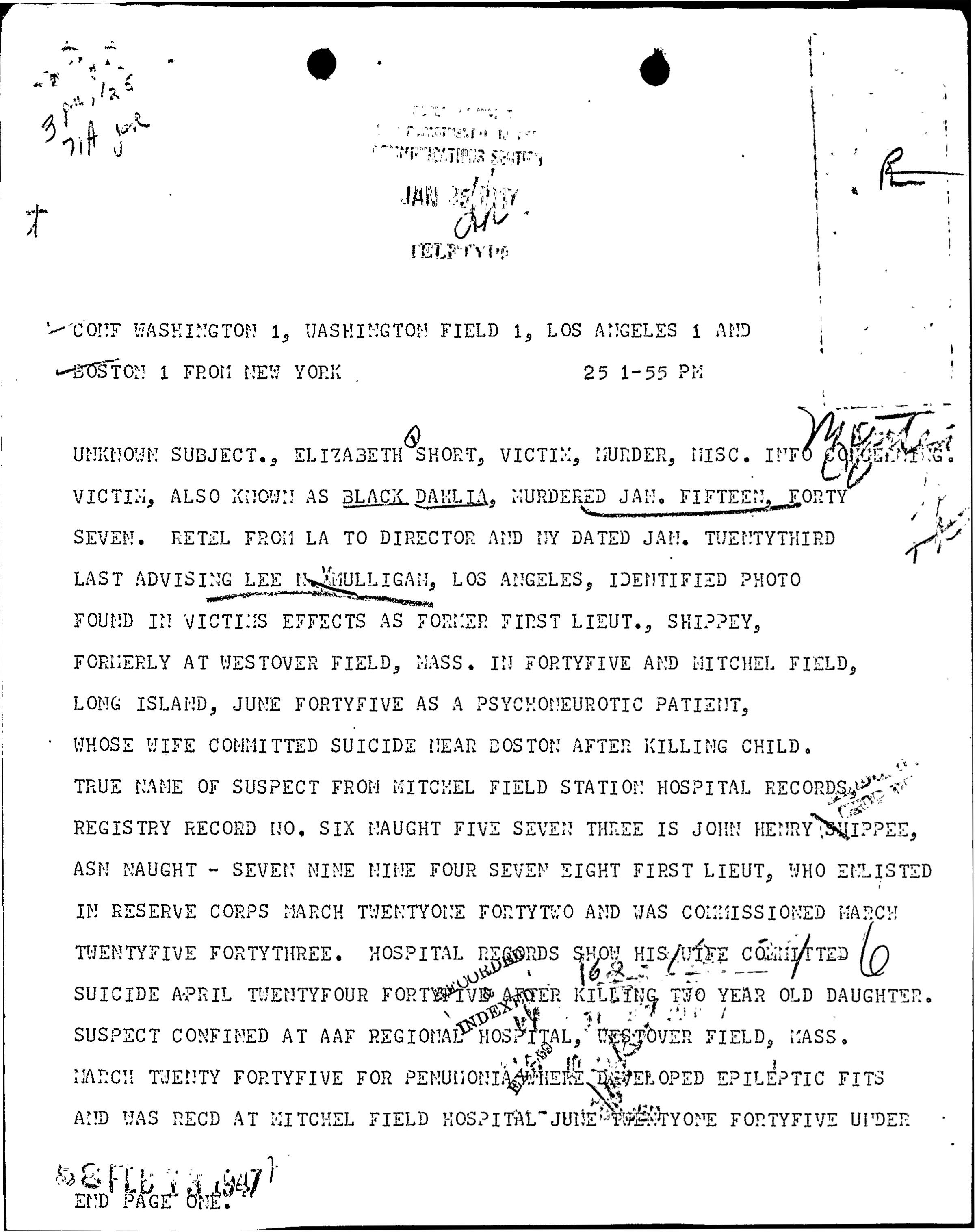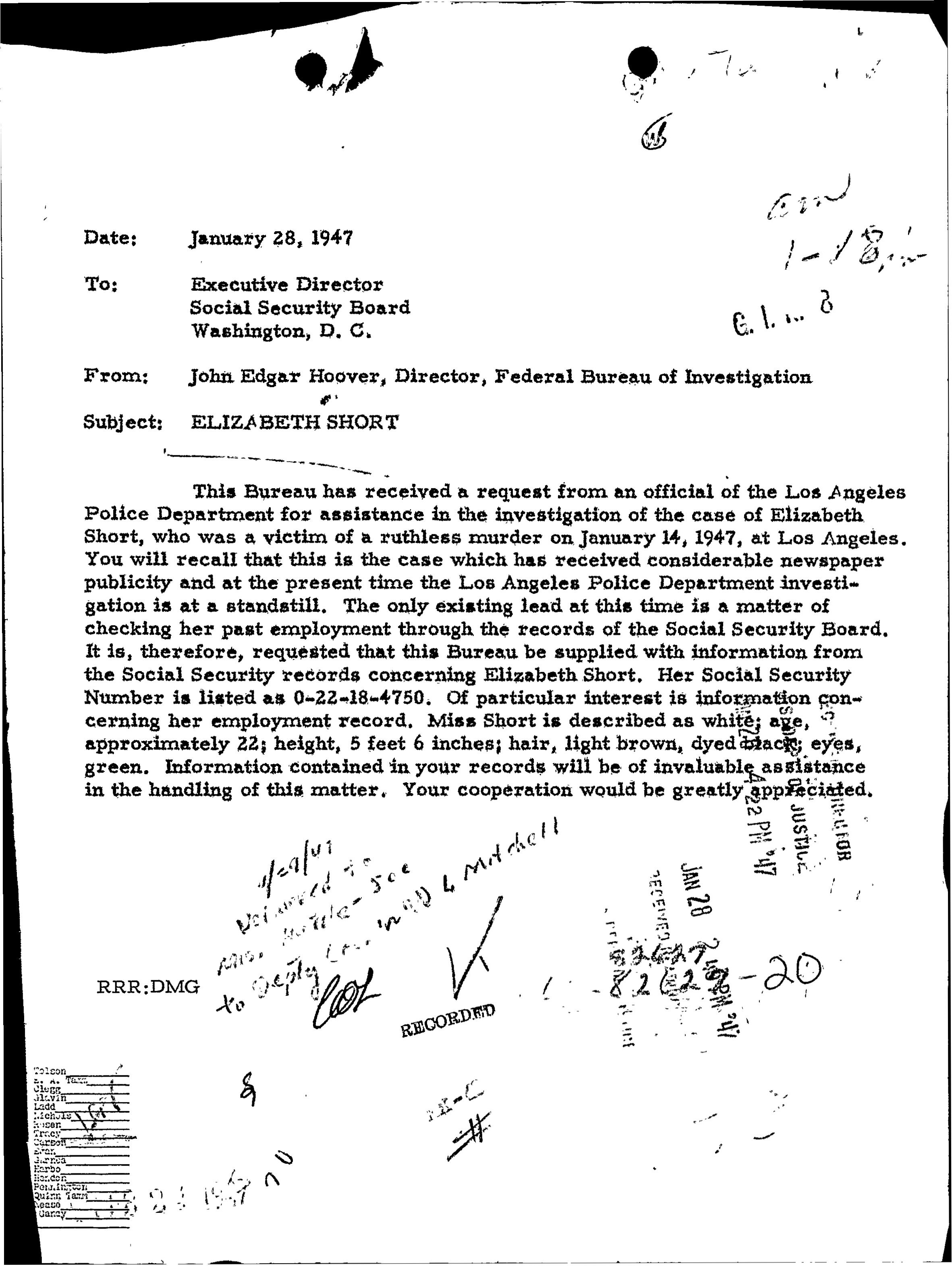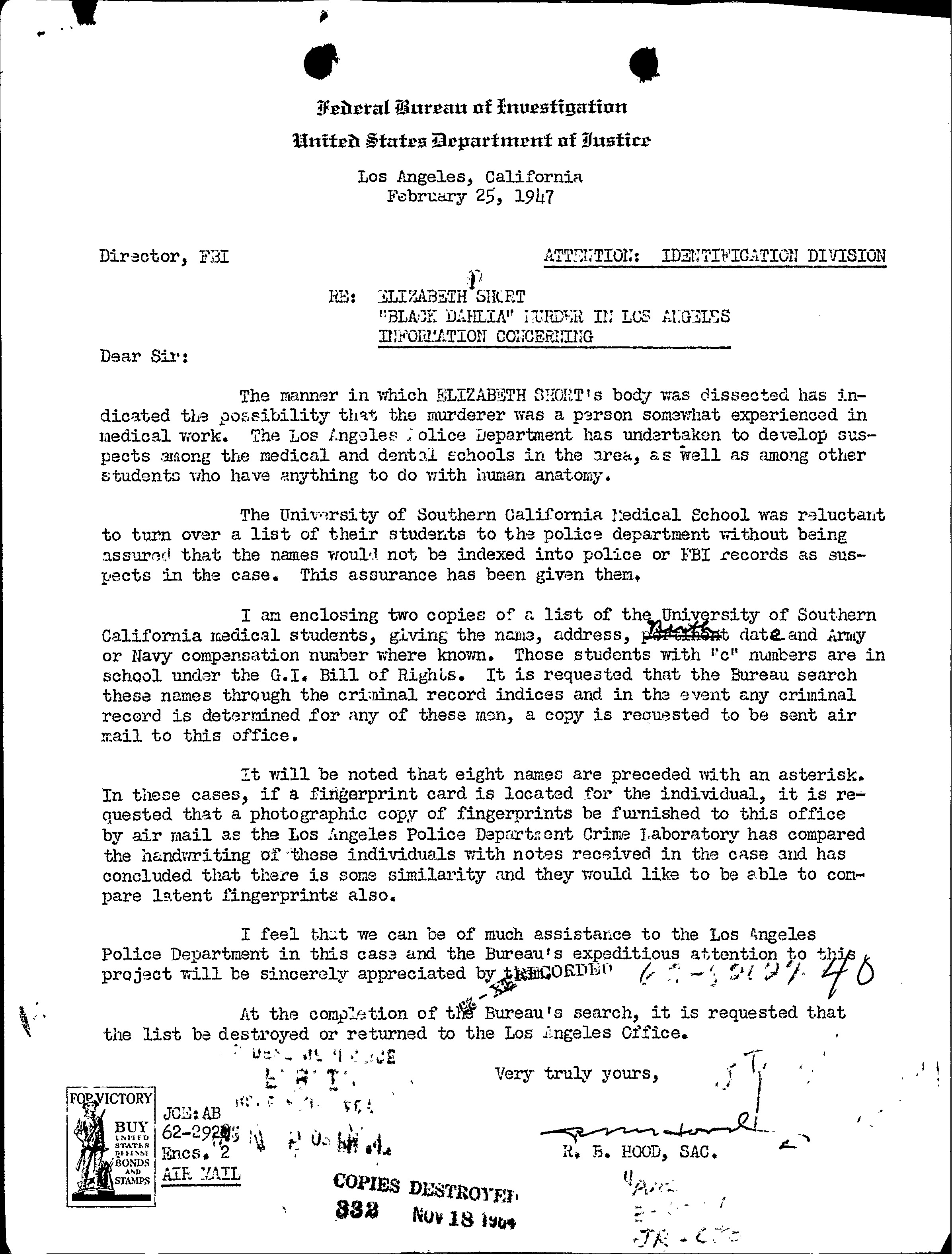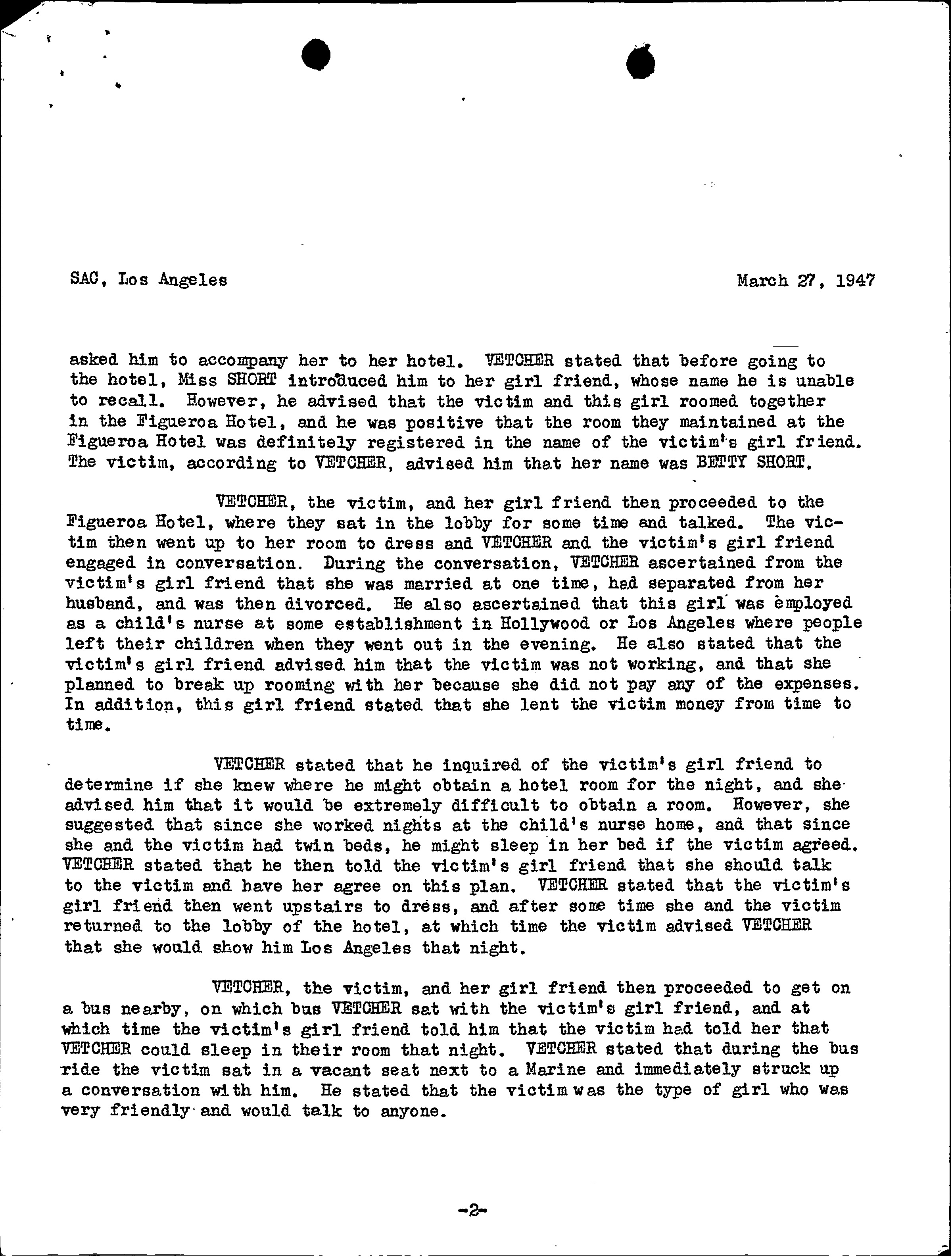|
|
|||||||||||||
|
|
|||||||||||||
|
FREE COLLECTION |
|||||||||||||||||
|
Black Dahlia - Elizabeth Short Murder Los Angeles Police Department Files, FBI Files, Newspaper Coverage |
|||||||||||||||||
|
Black Dahlia - Elizabeth Short Murder Los Angeles Police Department Files, FBI Files, Newspaper Coverage 615 pages (not including duplicate FBI files) of Los Angeles Police Department files, FBI files, newspaper articles & photographs. On January 15, 1947, the body of Elizabeth Short was found in a vacant lot in Los Angeles, at 3800 Norton Ave, near 39th Street. She was found by a mother walking with her young child in the Los Angeles Leimert Park neighborhood. One foot off the sidewalk she saw a young naked woman sliced clean in half above the naval. Elizabeth Short went to Hollywood three years earlier, seeking a career as a movie actress. Instead, Elizabeth, or Betty as she was known in her hometown of Medford, Massachusetts, ended up working a series of odd jobs. Ironically her murder at the age of 22, has made her one of the most famous women in the history of Los Angeles, staring in the role of the victim in Los Angeles' most famous unsolved murder case. Sensational news stories filled Los Angeles newspapers for months after the murder. Hearst's newspapers were especially consumed with the Black Dahlia case. About fifty men and women came forward over the coming weeks and years to confess to the Black Dahlia murder. They were known as "Confessing Sams" at the time. According to former Los Angeles Police Department homicide detective Brian Carr, the case came into his purview in 1996, all who confessed were ruled out as serious suspects. This collection contains: FBI Files 222 pages of FBI files covering the murder of Elizabeth Short, known as the Black Dahlia Murder. Include two copies of the files. A 206-page set released in 2004 and a 211-page set released in 2016, containing effectively the same material. The 2016 release is completely unredacted. The 2004 release is well redacted. This is a good chance to see what type of information is routinely redacted from FBI files when released to the public. There are approximately 5 pages in each release, that are not in the other. At the bottom of several of the memorandums are handwritten notations by FBI Director J. Edgar Hoover. The murder investigation was led by the L.A. Police Department, the FBI provided some assistance. After the discovery of the body. The then unidentified victim's fingerprints were scheduled to be airmailed to the FBI fingerprint identification division in Washington. The Los Angeles Herald Examiner Assistant Managing Editor Warden Woolard suggested to Los Angeles police Capt. Jack Donahoe, who was chief of the department's homicide division, that the victim's fingerprints be transmitted to the FBI by using the Examiner's new soundphoto machine (a primitive fax machine used by news services). During the early morning hours of January 16, the International News Photo wire service received the prints via photo transmission from the Examiner. Soon afterward, the FBI identified the victim as Elizabeth Short. Short’s prints actually appeared twice in the FBI’s collection, more than 100 million were on file at the time, first, because she had applied for a job as a clerk at the commissary of the Army’s Camp Cooke in California in January 1943; second, because she had been arrested by the Santa Barbara Police Department for underage drinking seven months later. Files include a variety of news clippings from the early days of the case. Copies of Short’s birth and death certificates. Various physical descriptions of Short at her death, including one that describes her as “white, female, twentytwo (sic), five ft. six, one eighteen lbs., hair light brown, died (sic) black, green eyes, bad teeth.” Contents include: The results of FBI record checks on potential subjects and info on interviews performed across the nation. In the first release the names are often blacked out. In the second release (2016) the names are unobscured. Memos on a request for the FBI to search for a match to fingerprints found on an anonymous letter that may have been sent to authorities by the killer. References to the extensive interference of the press in the case, they had arrived at the scene and taken pictures even before the police, including a comment by the FBI Special Agent in Charge in Los Angeles that, “it is not possible for the investigators to have a confidential telephone conversation or even read mail without some news reporter looking it over to see if it relates to this case.”
Based on early suspicions that the murderer may have had skills in dissection, because the body was so cleanly cut and mutilated, a memo suggests checking out students at the University of Southern California Medical School, not far from the crime scene. Copies of letters the FBI received from private citizens claiming to know the culprit.
Black Dahlia - Elizabeth Short Murder Los Angeles Police Department Files, FBI Files, Newspaper Coverage
Contains a memorandum on the FBI interview of an acquittance, who had a dalliance with Short, Peter Vetcher, he gives details about the time he spent with her when he was in Los Angeles.
Black Dahlia - Elizabeth Short Murder Los Angeles Police Department Files, FBI Files, Newspaper Coverage 70 pages of material from the Los Angeles Police Department Elizabeth Short murder case files. As it is policy with the Los Angeles Police Department that any case that is not solved is an open case, the LAPD Black Dahlia murder files are barred from the view of anyone other than the current detective assigned to the case. The LAPD also asserts that their Black Dahlia records are exempt from release under California's public records act, because the case files are investigatory and are exempt from release. However, the LAPD did temporarily lend several dozen original pages of the file to the Los Angeles Police Museum for their preparation of an exhibit on the history of the Black Dahlia Case. This collection includes copies of those documents. The files contain: Black and white photos of Elizabeth Short, family and friends of Short, and photos of the crime scene and surrounding area. Copies of "Description of Jane Doe at the Morgue" report, "Dead Body Report" and "Crime Against Person Report." Firsthand police accounts are found in an "Officers Memorandum" by LAPD officers Frank Perkins and Will Fitzgerald and in a "Follow-up Report" by detectives Harry Hansen and Finis Brown, the lead detectives on the Short case. The 5-page follow-up report lists persons interviewed and arrested and a four-page narrative of events written by Perkins and Fitzgerald, from the time they arrived on the murder scene on the morning of January 15th to February 4, 1947. Memorandum regarding the investigation of Christine Reynolds, mugshots, fingerprint card and news articles. On Saturday, November 25, 1950, Christine Reynolds surrendered to Oakland police, confessing to the murder of Short. She was quickly dismissed as a suspect when she could not provide details about the crime. Pages of documents regarding a suspected named David Rivenburgh. A letter from FBI director J. Edgar Hoover to LAPD Chief Clemence B. Horrall on results of a fingerprint examination of prints found on an anonymous letter that may have been sent to authorities by the killer. A memo noting that Woodrow Guthrie had been eliminated as a suspect. Woodrow Wilson Guthrie was an American singer-songwriter, one of the most significant figures in American western folk music. He is most famous for his song "This Land Is Your Land." According to Ed Cray, author of "Ramblin' Man: The Life and Times of Woody Guthrie," he drew police attention because of some sexually explicit letters and tabloid clippings about grisly murders he sent to a Northern California woman who he was allegedly stalking. The woman's sister contacted the LAPD. Guthrie was quickly cleared of involvement in the murder, but he was prosecuted for sending obscene materials through the mail and spent 10 days of a six-month sentence in jail. Files include a letter Guthrie sent to a woman in Oakland.
Also included are several crank letters.
79 photos from the Los Angeles Herald Examiner archives. The murder of Elizabeth Short may have fallen into obscurity if not for the Los Angeles Herald. The Herald was the first newspaper to break the story of the 1947 dismemberment murder of Short, who was ultimately dubbed the Black Dahlia by Los Angeles Herald-Express crime reporter Bevo Means. The Examiner continued to run stories on the murder and the investigation, which was front-page news for 35 days following the discovery of the body.
Photo subjects include suspects, family and friends of Elizabeth Short, personalities related to the case, evidence and the crime scene area. Where available included are write-ups of the photos written by Examiner staff.
Full sheet newspaper pages from 1947 to 1957, with articles covering the Black Dahlia/Elizabeth Short Case. California Newspapers - 158 pages from newspapers around California.
Outside California Newspapers - 47 pages from mostly The Washington Evening Star and the Wilmington North Carolina Star.
|
|||||||||||||||||
 |
|||||||||||||||||
 |
|||||||||||||||||
 |
|||||||||||||||||
 |
|||||||||||||||||
|
FREE COLLECTION |
|||||||||||||||||